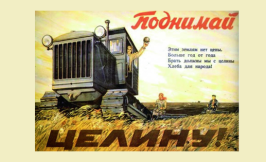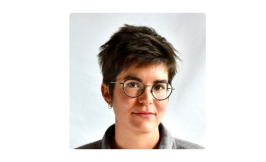PhD Student Spotlight: Gail Bratcher
- What drew you to the work you do on the environmental and agricultural history of the Soviet Union?
I’ve always had an affinity for rural folk, being one myself. (The study of history is, after all, a study of the self!) When I went to college in Baltimore and met all sorts of people, I saw how taken for granted rural places are. In the background, assumed to always exist, but definitely not worth exploring further. I saw this reflected in scholarship, too. In my first Soviet history course, we spent a lot of time discussing the violent collectivization of peasant lands in the 1930s, for good reason, but then peasants, the countryside, and agriculture largely dropped out of the picture. Historiography of WWII and the Khrushchev era focused almost entirely on urban spaces. And I thought to myself, shoot, how did people eat in 1962?! The Soviet Union was still a majority rural country until the late 1960s. That’s a lot of people we’re not talking about!
In terms of my interest in environmental and agricultural history—as opposed to narrowly focusing on rural societies and cultures—that came because I wanted to learn more about the science behind how dirt becomes plants becomes animals becomes dirt. (It turns out that it’s not magic.) I suddenly regretted not taking chemistry in high school and having to take earth science three times in college because I was too bored to go (true story; we were all young and dumb once). So, part of my project design was to force me to learn a bit about the science and practice of farming.
- What questions did you begin with as you were starting your dissertation research and where has the process taken you? What changes have you made and why?
My starting point for exploring agriculture and the environment in the late Soviet period was the Virgin Lands Campaign, which was the pet project of Nikita Khrushchev to cultivate grain on tens of millions of hectares of "virgin" grasslands of Eastern Ukraine, the Northern Caucasus, Western Siberia, and Northern Kazakhstan. It began in the spring of 1954 and is typically bookended by Khrushchev's ouster in 1964. This was basically all I knew of Soviet agriculture after WWII. I started digging (!!) into the literature on the environmental consequences of the Campaign, foremost among them being the catastrophic soil erosion that created a Dust Bowl-like situation. So, my dissertation began as an exploration of this soil science that emerged in response to this “Soviet Dust Bowl”. I was interested in the interplay between scientific and vernacular knowledge in this consolidation of dryland agricultural practices that were developed in the 1960s and 70s in Kazakhstan. That was my proposal, anyway.
Some years went by in the early 2020s, I’m not sure to where exactly, but anyway I finally made it to Kazakhstan to do archival research. Within the first few days of poking around the libraries of Astana, I came across a Kazakh leader referring to a “second” Virgin Lands Campaign. There were TWO?! I had never heard of a second! Kazakh leaders referred to the “second” Virgin Lands Campaign as the revitalization of the livestock sector of the economy that occurred as a result of the extensive grain cultivation that was the defining feature of the “first” Campaign. That reminded me of what Sarah Cameron revealed in her book The Hungry Steppe about the collectivization, famine, and forced sedentarization of the Kazakh nomads in the 1930s: by 1933, Kazakhs had lost 90% of their livestock herds in comparison with pre-Revolutionary levels. So, my questions shifted to: How was the Kazakh herd rehabilitated after such devastation? What was this “second” Virgin Lands Campaign? How are these two events connected? Or are they? Soil science still plays a role in my dissertation, but it is one part of a larger story about livestock. Cows, specifically.
- You took a research rip to Kazakhstan to initiate your project. I’d love to learn more about your experience in the archives and how it shaped your project.
The biggest surprise to me about this archival trip was appreciating all of the other little things that shape what you “discover” in the archive. For example, I went to the Archive of the President of Kazakhstan—where the Communist Party archives are held—in Almaty. They were in the process of digitizing their more contemporary files. Digitized archival documents, fantastic! But it took between 30 and 60 seconds to load a single page on their servers. A single page of the finding aid, a single page of a file. After about three hours of doing this, I lost my mind, and when they said I couldn’t have the paper copy, I decided to just stick to the state archive. At the state archive, I ran into trouble with the reading room attendants. I could only order three finding aids a day, and for the Ministry of Agriculture, one of the many ministries I needed for my project, there were something like 78 finding aids, with no discernible pattern to their organization. After a month of ordering, receiving, and returning (a four-day process), one of the attendants approached me to sign copies of the archive’s rules and regulations. Normally I wouldn’t read these things, but because the files I ordered for that day were all busts, I did. And I read that I could order SEVEN finding aids in a day! Imagine what progress I could have been making! I showed this to the archivists, and they were thoroughly unbothered by this oversight.
The point of these long, boring anecdotes is to say that I had this romantic fantasy about going into The Archive and reading until my heart was content and knowing the ins and outs of my topic, when the fact of the matter is, I don’t know much about what the Communist Party is saying during this time because the servers were too slow at the archive and I could only be in Kazakhstan for eight months and this is what I got.
- What has been your experience at UChicago and have there been any particularly formative or notable moments?
I can’t think of a single moment, because this whole experience has been a dream. The people here are searingly brilliant and remarkably compassionate—faculty, students, administrators, the whole lot—and I will be forever grateful to have spent these eight years in their company.
- Of course, research and writing is not all you do. What are some activities outside of your work as a historian that you enjoy?
We all spend too much time in our heads, so when I’m not working, I try to get back in my body as immediately as possible. I like all of the movement practices, I’m not picky, although I have a strong preference for moving outdoors. I love to grow and cook and eat food. To access the spirit, I add people to the mix: run with my siblings, feast with friends, and play The Floor Is Lava with my nieces and nephews—the true lights of my life. To tend to my reptilian brain, I like to go to Jimmy’s and watch Baltimore Ravens football, drink a bitters and soda, and heckle all the haters. I’m a simple gal, really.
 THE UNIVERSITY OF CHICAGO
THE UNIVERSITY OF CHICAGO





